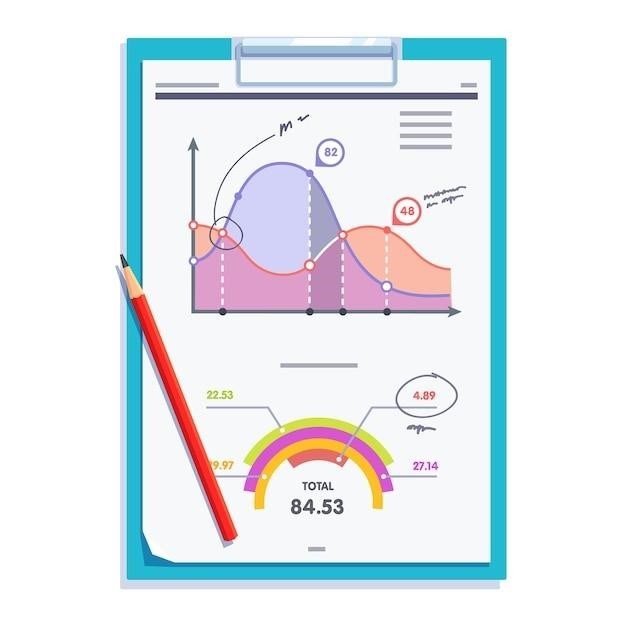Domain and Range of Graphs Worksheets⁚ A Comprehensive Guide
These worksheets are ideal for beginners, introducing them to the concepts of domain and range through simple functions. Understanding domain and range is crucial in mathematics, particularly in functions. Domain represents all possible input values for a function, while range signifies all possible output values.
Introduction to Domain and Range
Domain and range are fundamental concepts in mathematics, particularly when dealing with functions and their graphical representations. The domain of a function refers to the set of all possible input values (often represented by the variable ‘x’) for which the function is defined. In simpler terms, it’s the set of numbers you can plug into the function and get a valid output. The range, on the other hand, encompasses all possible output values (often represented by the variable ‘y’) that the function can produce. It’s the set of all possible results you can get from the function.
Understanding domain and range is essential for comprehending the behavior of functions and their graphs. It allows us to determine the limits of the function’s input and output, providing valuable insights into its properties and applications.
Domain and Range in Graphs
Visualizing domain and range becomes much clearer when we consider graphs. The graph of a function provides a visual representation of its input-output relationship. To determine the domain from a graph, we look at the x-values that are included on the graph. The domain includes all the x-values where the graph exists. To find the range, we examine the y-values that are present on the graph. The range encompasses all the y-values the function can produce.
For example, if a graph extends indefinitely to the left and right, the domain would be all real numbers. Similarly, if the graph extends infinitely upwards and downwards, the range would also be all real numbers.
Determining Domain and Range from Graphs
Understanding how to identify the domain and range from a graph is a fundamental skill in algebra. To pinpoint the domain, we look for the x-values covered by the graph. If the graph extends infinitely to the left and right, the domain is all real numbers. However, if the graph has a limited horizontal span, we note the minimum and maximum x-values, representing the domain.
Determining the range involves focusing on the y-values. If the graph extends infinitely upwards and downwards, the range is all real numbers. If the graph has a limited vertical span, we identify the minimum and maximum y-values, which define the range. These principles apply whether the graph represents a linear, quadratic, exponential, or any other type of function.

Identifying Functions from Graphs
A key aspect of working with graphs is understanding whether they represent functions. The vertical line test provides a simple visual method to determine this. If any vertical line intersects the graph at more than one point, the graph does not represent a function. This indicates that for a single input value (x-coordinate), there are multiple output values (y-coordinates), violating the definition of a function.
Conversely, if every vertical line intersects the graph at only one point, the graph represents a function. This means that for each input value, there is only one unique output value. Understanding the vertical line test is essential when working with domain and range, as it clarifies the nature of the relationship between input and output values depicted in a graph.
Types of Graphs and Their Domain and Range
Different types of graphs have unique characteristics that influence their domain and range. For example, linear functions have a domain of all real numbers, as they extend infinitely in both directions. Their range also encompasses all real numbers, as the line continues indefinitely upwards and downwards. In contrast, quadratic functions, which are shaped like parabolas, have a domain of all real numbers but a range that depends on whether the parabola opens upwards or downwards.
Understanding the specific properties of different graph types is crucial for accurately determining their domain and range. Worksheets often provide a variety of graph types, including linear, quadratic, polynomial, exponential, and trigonometric functions, allowing students to practice identifying their domain and range based on their unique characteristics.
Linear Functions
Linear functions are represented by straight lines on a graph. They are defined by equations of the form y = mx + c, where m is the slope and c is the y-intercept. The domain of a linear function is always all real numbers, meaning that any value of x can be input into the equation. The range is also all real numbers, as the line extends infinitely in both directions, covering all possible y-values.
Worksheets often include exercises where students are given the equation of a linear function and asked to determine its domain and range. By understanding the concept of domain and range for linear functions, students can readily identify the possible input and output values for any given linear equation.
Quadratic Functions
Quadratic functions are represented by parabolas on a graph. They are defined by equations of the form y = ax² + bx + c, where a, b, and c are constants. The domain of a quadratic function is always all real numbers, as any value of x can be plugged into the equation. However, the range depends on the shape of the parabola.
If the parabola opens upwards (a > 0), the range is all real numbers greater than or equal to the y-coordinate of the vertex. If the parabola opens downwards (a < 0), the range is all real numbers less than or equal to the y-coordinate of the vertex. Worksheets often present graphs of quadratic functions and ask students to identify the domain and range based on the shape and vertex of the parabola.

Polynomial Functions
Polynomial functions are defined by equations with multiple terms, each consisting of a coefficient and a variable raised to a non-negative integer power. These functions can produce graphs with various shapes, including curves and turning points. While the domain of a polynomial function is always all real numbers, the range can be more complex.
Worksheets on polynomial functions often present graphs of different degrees and ask students to determine the domain and range based on the graph’s behavior. This may involve identifying the highest and lowest points on the graph, as well as any limitations on the range imposed by the function’s shape. Students will need to apply their understanding of polynomial function properties to accurately identify the domain and range.
Exponential Functions
Exponential functions, characterized by a constant base raised to a variable exponent, are known for their rapid growth or decay. Their graphs exhibit a distinctive curve that either rises or falls sharply, depending on the base. These functions are often used to model real-world phenomena like population growth or radioactive decay.
Worksheets on exponential functions typically involve analyzing graphs and identifying the domain and range. The domain of an exponential function is usually all real numbers, while the range depends on the function’s behavior. Students will need to recognize whether the graph approaches a horizontal asymptote, indicating a specific range, or if it extends infinitely in one direction. Understanding the properties of exponential functions is key to accurately determining the domain and range from their graphs.
Trigonometric Functions
Trigonometric functions, like sine, cosine, and tangent, are essential in describing periodic phenomena, such as wave patterns or oscillations. Their graphs exhibit a repeating pattern, with specific intervals representing the period of the function. Understanding the domain and range of these functions is vital for analyzing their behavior and solving trigonometric equations.
Worksheets on trigonometric functions often involve analyzing graphs and identifying the domain and range. The domain of trigonometric functions is usually restricted to specific intervals, determined by the function’s period. The range, on the other hand, is limited by the maximum and minimum values the function can reach. Students will need to analyze the graph’s amplitude and period to determine the function’s domain and range accurately. These worksheets provide valuable practice for students to grasp the concepts of domain and range in the context of trigonometric functions.
Domain and Range in Interval Notation
Interval notation is a concise way to represent the domain and range of functions using parentheses and brackets. Parentheses indicate that the endpoint is not included in the interval, while brackets signify that the endpoint is included. This notation is particularly useful when dealing with continuous functions, where the domain and range can be expressed as a continuous set of values.
Domain and range worksheets often feature exercises that require students to express the domain and range in interval notation. Students will need to analyze the graph to identify the minimum and maximum values of the function, and then use parentheses or brackets to denote whether the endpoints are included or excluded. This practice helps students develop a deeper understanding of interval notation and its application in representing the domain and range of functions.
Domain and Range in Set Builder Notation
Set builder notation is a more formal way to express the domain and range of functions using mathematical symbols. It involves defining a set of values that satisfy certain conditions. This notation is particularly useful when describing discrete functions or functions with restricted domains or ranges.
In set builder notation, the domain and range are represented using braces { } and a vertical bar |. The part before the vertical bar defines the variable and the type of values it can take, while the part after the vertical bar specifies the condition that the values must satisfy. Domain and range worksheets often include exercises that require students to express the domain and range in set builder notation. This practice helps students develop a deeper understanding of set theory and its application in representing the domain and range of functions.
Domain and Range Worksheets for Practice
Domain and range worksheets are invaluable tools for reinforcing these concepts and improving student understanding. These worksheets offer a variety of exercises that cater to different learning styles and skill levels. Some worksheets focus on identifying the domain and range from graphs, while others involve analyzing sets of ordered pairs or equations.
By working through these practice problems, students can develop their ability to interpret graphs and understand the relationship between input and output values. This practice is essential for building a solid foundation in algebra and preparing students for more advanced mathematical concepts. Domain and range worksheets are easily accessible online and can be customized to meet specific learning objectives.
Domain and Range Resources for Teachers
Teachers can find a wealth of resources to support their domain and range instruction. Websites like Teachers Pay Teachers offer a wide range of printable worksheets, lesson plans, and activities specifically designed for teaching domain and range. These resources often include differentiated activities, answer keys, and engaging visuals to cater to diverse learning needs.
Additionally, online platforms like Kuta Software provide customizable worksheets that allow teachers to generate problems tailored to specific grade levels and skill levels. These platforms often offer a variety of question formats, including multiple choice, true/false, and open-ended problems, allowing teachers to create engaging and effective practice materials.
Mastering domain and range is essential for understanding functions and their applications in various mathematical fields. By utilizing domain and range worksheets, students can develop a solid foundation in these concepts, enhancing their problem-solving abilities and analytical skills. Teachers can leverage the numerous resources available online to create engaging and effective learning experiences for their students. With consistent practice and a strong understanding of domain and range, students can confidently tackle more complex mathematical concepts.
